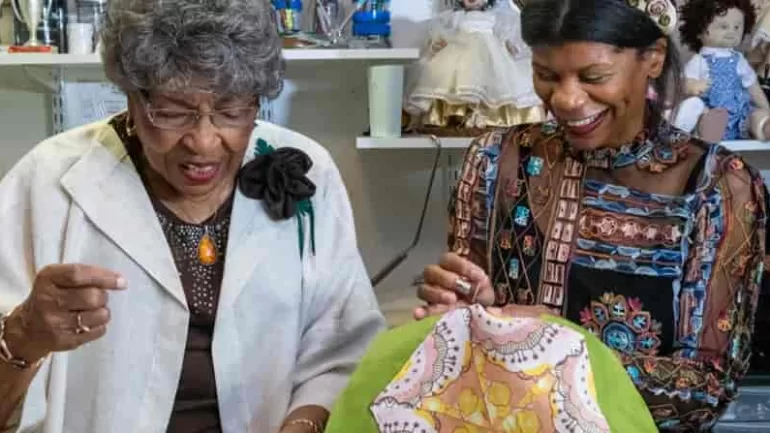ART NEWS
Mentor artist Catherine Wooten and artist Suzanne Coley during one of Maryland Traditions activities. The Maryland Arts funding cuts may affect this program.
Budget cuts to Maryland arts funding put cultural institutions at risk. Explore the consequences and advocacy efforts to protect Maryland’s arts sector.
BY KAZEEM ADELEKE, ARTCENTRON
BALTIMORE, MARYLAND–Governor Wes Moore’s decision to cut $440,000 from the Maryland State Arts Council (MSAC) has sent shockwaves through the state’s arts community. These reductions are raising concerns about the sustainability of local arts programs, nonprofit organizations, and independent artists.
The Maryland State Arts Council, operating under the Department of Commerce, has long been a crucial source of funding for artistic initiatives across the state. It distributes grants to theaters, museums, performing arts groups, and individual creators, ensuring the growth of Maryland’s cultural economy. The proposed funding reduction threatens to curtail these efforts, diminish programming, and weaken support structures for artists and community-based organizations.
A Stark Contrast: From Record Investments to Funding Cuts
In September 2023, Governor Moore celebrated a historic $40 million investment in the arts through the Arts Relief initiative, positioning Maryland as a leader in per capita arts funding nationwide. This move was aimed at alleviating the financial hardships arts organizations faced due to the COVID-19 pandemic, shifting audience behavior, and inflation.
However, the proposed budget cuts for 2024 appear to reverse that progress, leaving many in the arts sector feeling abandoned. Nancy Proctor, Chief Strategy Officer at The Peale, warned that such reductions could wipe out critical small grants that sustain local arts initiatives, especially in historically underfunded communities. These cuts could also disrupt youth outreach programs and reduce job opportunities within the state’s creative economy.
The Economic and Social Impact of Arts Funding Cuts
The Maryland arts industry is not just a cultural asset but an economic driver. Arts organizations contribute millions of dollars to the state’s GDP, support thousands of jobs, and attract tourists who spend money on hotels, restaurants, and local businesses. The arts play a vital role in education, fostering creativity and innovation that extend into STEM fields, entrepreneurship, and community development.
Reducing funding now could have a ripple effect, leading to:
- Job losses among artists, administrators, and technical staff. Cancellations of public performances, exhibits, and educational programs. Without sufficient support, theaters, galleries, and music venues struggle to survive.
- Decreased funding for community-based art projects that uplift underserved populations. The arts reflect Maryland’s diverse communities. Budget cuts threaten this diversity by limiting support for underrepresented artists and cultural initiatives. A loss of funding weakens the state’s rich artistic identity.
- Weakened cultural tourism, reducing revenue for local businesses. Budget cuts don’t just impact artists; they affect local businesses and tourism. Restaurants, hotels, and shops depend on arts events to attract visitors.
Arts Leaders Speak Out Against the Budget Cuts
Arts leaders and artists oppose the budget cuts. They emphasize the severe impact on Maryland’s cultural landscape. The cuts, they contend, threaten both vibrancy and diversity. They note that reduced funding affects everyone, including performers and local businesses that depend on arts-driven tourism. Additionally, they point to how inflation and shifting audience behaviors worsen the situation. Unanimously, they emphasize that funding remains essential to prevent economic disaster for arts organizations.
The State’s Justification for the Arts Budget Reductions
Maryland is facing a projected $3 billion budget deficit, prompting Governor Moore’s administration to reassess state expenditures. The proposed budget includes not only spending cuts but also tax increases on high-income earners.
According to a spokesperson for Governor Moore, the arts cuts were a difficult but necessary decision to maintain fiscal stability while still prioritizing investments in public safety, education, and economic growth.
Who Will Be Most Affected by the Maryland Arts Funding Cuts?
The budget cuts will have a disproportionate impact on smaller and community-based organizations, particularly those serving historically marginalized communities. While larger institutions like the Baltimore Museum of Art or Kennedy Center may find alternative funding sources, many grassroots organizations and independent artists lack the same financial resilience.
Organizations at Risk Include:
- Baltimore Symphony Orchestra – Likely to face program cancellations and potential staff reductions.
- Maryland Art Place – Could struggle to maintain exhibitions and support emerging artists.
- Local Theaters and Arts Nonprofits – May be forced to cancel productions, workshops, and youth outreach initiatives.
Mobilizing to Protect Maryland’s Arts Sector
As backlash grows, arts advocates are rallying to prevent further funding cuts. Key efforts include:
- Petitions and Public Statements: Advocates are gathering thousands of signatures to demonstrate public opposition to the funding reductions.
- Legislative Lobbying: Meetings are being held with state lawmakers to push for restoring arts funding in the final budget negotiations.
- Community Protests and Demonstrations: Artists and supporters are organizing public events to raise awareness of the arts’ economic and cultural importance.
What’s Next for Maryland’s Creative Economy?
The battle over Maryland’s arts funding is far from over. As budget negotiations continue, arts leaders, local businesses, and residents are making their voices heard. The coming months will determine whether Maryland’s commitment to the arts remains strong—or whether the sector will face a detrimental funding shortfall that could take years to recover from.
For now, the arts community remains united in its efforts to fight for the funding it deserves—not just for artists but for the economic and cultural future of Maryland.
- Featured Image: Mentor artist Catherine Wooten (left; Howard County) and apprentice artist Suzanne Coley (right; Baltimore County) sew quilt squares in a 2021-22 Folklife Apprenticeship in sharecropper-style quilting. Photo: (MSAC)
